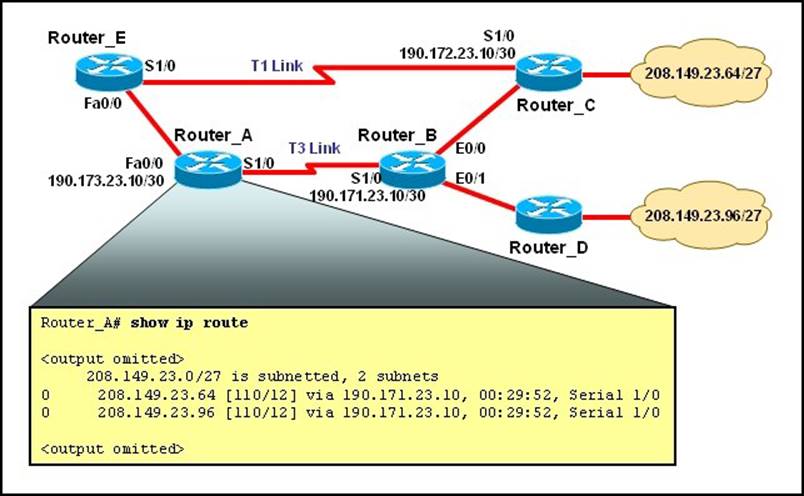- All Exams Instant Download
After link-state advertisements are received from Router_A, what information will Router_E contain in its routing table for the subnets 208.149.23.64 and 208.149.23.96?
Refer to the exhibit.

The network is converged.
After link-state advertisements are received from Router_A, what information will Router_E contain in its routing table for the subnets 208.149.23.64 and 208.149.23.96?
A . O 208.149.23.64 [110/13] via 190.173.23.10, 00:00:07, FastEthernet 0/0
O 208.149.23.96 [110/13] via 190.173.23.10, 00:00:16, FastEthernet 0/0
B . O 208.149.23.64 [110/1] via 190.172.23.10, 00:00:07, Serial 1/0
O 208.149.23.96 [110/3] via 190.173.23.10, 00:00:16, FastEthernet 0/0
C . O 208.149.23.64 [110/13] via 190.172.23.10, 00:00:07, Serial 1/0
O 208.149.23.96 [110/13] via 190.172.23.10, 00:00:16, Serial 1/0
O 208.149.23.96 [110/13] via 190.173.23.10, 00:00:16, FastEthernet 0/0
D . O 208.149.23.64 [110/3] via 190.172.23.10, 00:00:07, Serial 1/0
O 208.149.23.96 [110/3] via 190.172.23.10, 00:00:16, Serial 1/0
Answer: A
Explanation:
Router_E learns two subnets subnets 208.149.23.64 and 208.149.23.96 via Router_A through FastEthernet interface. The interface cost is calculated with the formula 108 / Bandwidth. For FastEthernet it is 108 / 100 Mbps = 108 / 100,000,000 = 1. Therefore the cost is 12 (learned from Router_A) + 1 = 13 for both subnets – B is not correct.
The cost through T1 link is much higher than through T3 link (T1 cost = 108 / 1.544 Mbps = 64; T3 cost = 108 / 45 Mbps = 2) so surely OSPF will choose the path through T3 link -> Router_E will choose the path from Router_A through FastEthernet0/0, not Serial1/0 – C & D are not correct.
In fact, we can quickly eliminate answers B, C and D because they contain at least one subnet learned from Serial1/0 – they are surely incorrect.
Latest 200-105 Dumps Valid Version with 312 Q&As
Latest And Valid Q&A | Instant Download | Once Fail, Full Refund
Subscribe
Login
0 Comments
Inline Feedbacks
View all comments

